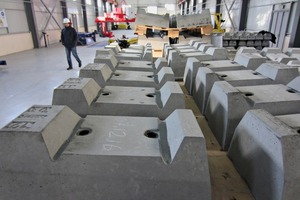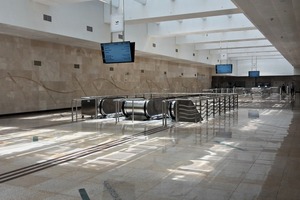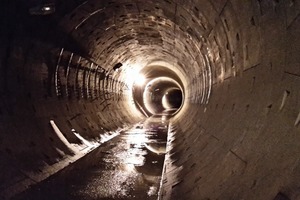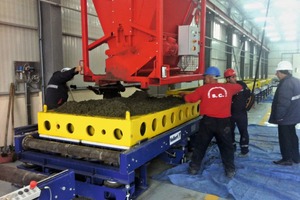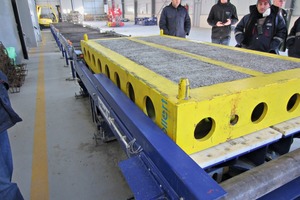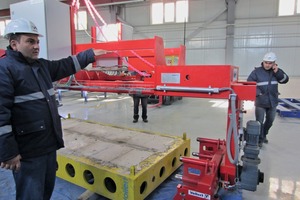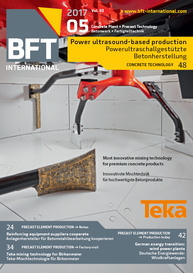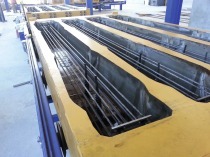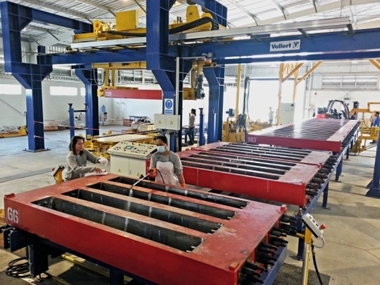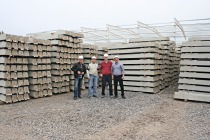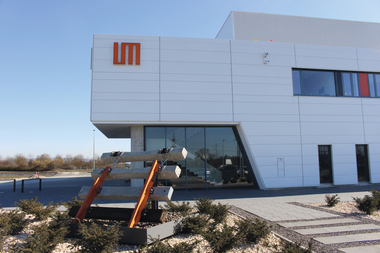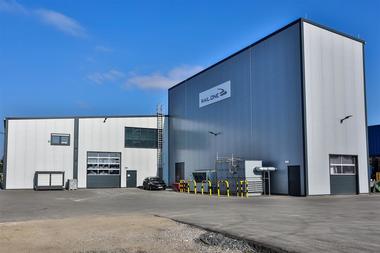New type of concrete sleeper system
for Baku’s metro lines
Vollert Anlagenbau GmbH is currently realizing a new production plant for concrete sleepers in Baku. In addition to the state-of-the-art plant technology, the project involves extensive engineering services for the design and implementation of the metro’s track system in Azerbaijan‘s capital city.
Plant specialist Vollert GmbH is currently realizing a new production plant for concrete sleepers in Baku. In addition to development services for the state-of-the-art plant technology, the project involves extensive engineering services for the design and implementation of the metro’s track system in Azerbaijan‘s capital city. As engineering partner and general contractor, the Weinsberg-based machine manufacturer is offering this service as part of its portfolio.
Baku, the booming metropolis of Azerbaijan on the Caspian Sea, is one of the fastest-growing cities in the Commonwealth of Independent States (CIS). In the past ten years alone, oil and gas have led to an increase in economic growth of 35 %. The infrastructure of the metropolis with a population of 2.2 million is barely keeping pace with this growth momentum, including public transport. Following independence and the related economic decline, tramway and trolley bus services were discontinued several years ago. Since that time, the now privatized metro has been channeling over 200 million passengers per year through the ground beneath Baku. On a transport network of currently 36.7 km, in excess of 720,000 passengers per day are carried between the 25 tunnel stations of Line 1 and a completed leg of Line 3.
Vollert’s expertise won the bid
Not only has the metro in Baku, which was begun as early as 1932 and expanded between 1967 and 1980, almost reached its capacity limit of 750,000 passengers per day, but it also uses outdated technology which no longer meets current standards. State President Ilham Aliyev, who wants to adopt European standards in business and technology, initiated an urban development plan for the capital city in 2009. A central aspect is the reconstruction and expansion of the metro network to a total length of 119 kilometers by 2030. The plan includes the construction of 55 new metro stations and three new lines; in addition, it is intended for Line 3 to be completed and expanded as a circle route.
Paris-based engineering office Systra, a French specialist for the design and development of railway traffic and urban rail-bound public transport, has drawn up a master plan for the €5.6 billion project and begun with its implementation in 2012. Vollert Anlagenbau GmbH has been on board since the beginning of 2016. “The track system was not included in the scope of services offered by Systra. That is why Baku Metropolitan CJSC, founded by State President Aliyev on February 27, 2014, was looking for a service provider who covered everything related to the track system: design of the track network, production of the concrete sleepers, and construction of the network; they came across us via our references such as the Gotthard Tunnel or concrete sleeper plants in the Turkish city of Afyon or in the Mexican city of Monterrey,” says Steffen Schmitt, Sales Manager for concrete sleeper plants at Vollert.
Cooperation with engineering office and concrete specialist
It became clear very quickly that it was not merely a question of building a plant for the production of concrete sleepers but also of planning extensive engineering services. “Our job was to plan the entire track system based on the latest technical standards, to design the new sections accordingly, to sever the interfaces to the existing track system, to redesign dilapidated legs, and to design the new concrete sleeper plant so that it would cover both current and future requirements,” says Schmitt. In cooperation with Dipl.-Ing. Jürgen Rademacher from Berlin-based Büro für Verkehrsin-genieurbau (Office of Traffic Engineering) and Dipl.-Ing. Andreas Titze, a specialist in concrete technology, Vollert has planned, designed and then tested the entire track system under real-life conditions on a test track. In the process, a number of issues were solved from the substructure via the type of concrete and reinforcement to be used all the way to the switches and corridors.
The existing track network of the Baku metro dates back to an early type of slab track. This system uses tar-impregnated wooden sleepers which are underpoured with concrete after installation of the rails, providing a gutter in the center that is kept clear to allow drainage. Wooden sleepers are fairly short-lived, requiring frequent maintenance and extensive repair. It often happens that longer sections need to be repaired which, in underground tunnel systems, is associated with a temporary closure and significant revenue losses. Concrete sleepers have the advantage that their higher weight gives them increased stability. “In addition to that, they require less maintenance, are more environmentally friendly and have a considerably longer life. The customer’s requirement specified a durability of up to 50 years,” says Steffen Schmitt. As a result, maintenance intervals become less frequent, repairs are associated with less effort, and refurbishment is required in significantly longer time intervals.
Vollert-Rheda system has the advantage
For the construction of slab tracks in the new sections, Vollert relies on the Rheda system: in 1972, at the railway station of the town of Rheda-Wiedenbrück in Westphalia, a slab track was built on a public railway line in Germany for the first time, replacing the conventional ballast-sleeper type of construction as a superstructure. It consists of a thick, hydraulically bound base layer on which a reinforced concrete slab is raised. The concrete sleepers are then aligned on top of the slab and fixed in place using infilling concrete which forms a bond with the underlying supporting slab through the use of reinforcement. Compared to conventional ballasted tracks, the system is very rigid, however, and offers little elasticity. “We have spent a great deal of time studying this system and have developed a special design for the superstructure with the result that both the production and installation of our concrete sleepers have become a lot easier,” Schmitt explains. The Vollert-Rheda system offers an elegant fastening solution. It is secured quickly and simply by means of a single anchor, which simplifies installation as well as maintenance and repair. In addition, the fastening system developed in cooperation with Vossloh offsets the disadvantages associated with slab tracks: it reduces noise levels and absorbs vibrations and shocks, thus offering a high level of passenger comfort.
In addition to designing the track system, Vollert has taken on the job of supervising construction. “This is the only way for us to ensure that our concept is implemented as planned and that the concrete sleepers developed by us and produced locally can fully perform their function,” says Schmitt. The engineers in charge are present on site all the time to monitor the progress of construction.
Customized engineering package and state-of-the-art plant technology
In parallel to planning the track system, Vollert has designed a plant for the manufacture of made-to-measure concrete sleepers for the metro line. This also required an extensive engineering package and state-of-the-art machine technology. “To meet the specific environmental and installation conditions presented by the metro in Baku, we needed to develop a customized concrete mix design and draw up a test plan for continuous quality assurance in fresh and hardened concrete testing,” explains Igor Chukov, the Sales Manager for Russia and the CIS at Vollert. The sleepers had to be designed in accordance with the maximum axle load of 50 t, the maximum speed of 50 km/h, and the fastening coefficients; the position of the fastening system had to be determined; the design parameters had to be coordinated with the structural engineer; and the system had to be checked in terms of its cost effectiveness. The innovative sleeper design developed for the Baku metro provides optimum stiffness and an even distribution of the oscillating force. The sleepers are produced to an accuracy in size of +/- 1 mm.
“In the design stage of the concrete sleeper production plant, we decided in favor of a semi-automated mold circulation system offering flexible cycles, a high level of operational safety and sustainable processes,” Chukov outlines the conception of the plant. Four rigid steel frames with four mold troughs each have been combined to form a sleeper block mold. The mold passes through the different stages of production on a mold circulation system fitted with rollers. A frequency-controlled 1.5-kW electric motor drives a 1.5-m wide roller conveyor which, via toothed belts, ensures a roller conveyor belt speed of up to 0.3 m/s. In a first step, the sleeper block molds are cleaned using compressed air, then oiled and, prior to pouring the concrete, provided with the reinforcement and anchors for subsequent fastening of the rails. The reinforcement is prefabricated locally at the plant. In the next step, the concrete is poured into the molds in a manual process using a manually operated crane-mounted concrete spreader with a capacity of approx. 1.5 m³. The concrete is produced in a mixing plant integrated in the precast plant. The concrete hopper is fitted with a special segmented gate and a discharge roller. “Even spreading of the concrete can thus be ensured,” stresses the Vollert project manager. During pouring of the concrete, the sleeper mold is transported to a vibrating station where the concrete is compacted by means of a high-frequency external vibrator. After that, the sleeper mold is loaded into a temperature-controlled curing chamber and cured. When curing of the sleepers is complete after a few hours, they are removed from the curing chamber and transported to a demolding station where they are turned by means of a manipulator and then removed from the mold at the push of a rocker plate. After demolding, the mold is turned back into its original position and fed back into the mold circulation system. The demolded concrete sleepers are transported to the rail support installation section where they are provided with the prefabricated fasteners and are then either stocked or supplied to the construction site ready for placing.
First sections to be completed for 50-year anniversary
At the concrete sleeper plant, up to 30,000 sleepers per year can be produced using 20 sleeper molds. Only 50 percent of this capacity is currently utilized, however, and the concrete sleepers are produced for stock. There will be a significant increase in the daily production rates when construction is in full swing during the summer months. It is envisaged for construction stages 2 and 3 to be completed by November of this year together with several new metro stations along Line 3. This is when the metro of Baku will celebrate its 50-year anniversary. Numerous international guests will be invited to attend the opening ceremony, including many metro builders from all parts of the world. “The international trade press will have a close look at the solutions we have provided. We are looking forward to the event and are proud to play a major role in the modernization and expansion of one of the most important metros in the CIS countries,” says Steffen Schmitt.

